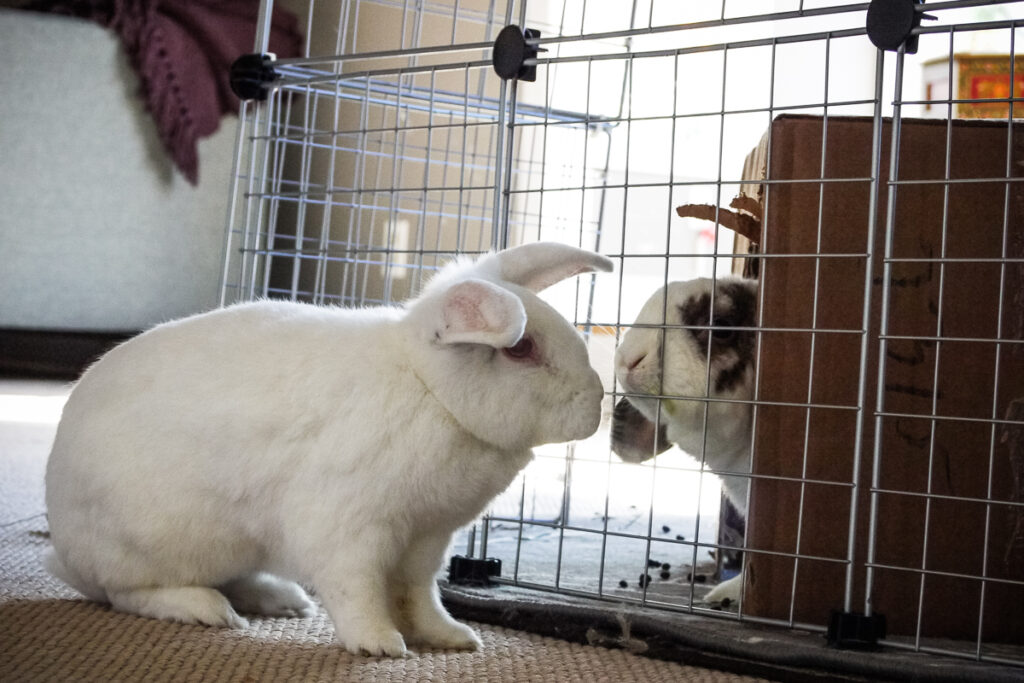Prerequisites for a successful introduction
Before attempting an introduction, the rabbits should be spayed or neutered, and you should wait for a full two weeks after the surgery before proceeding with the introduction. This delay both ensures proper healing and gives the hormones a chance to dissipate. This delay is especially important with a newly neutered male, as a male bunny can still be fertile for two weeks after fixing.
Many of the calls we receive are from well-meaning rabbit caregivers who bring a new rabbit home, put him with their existing rabbit, and think all will be fine. Sadly, these hasty introductions often result in serious harm or injury from biting, chasing, or other forms of attack.
In addition, rabbits are not quick to forget, so a bad fight could hinder future bonding sucess. Taking the time, reading up, and waiting for two spayed or neutered rabbits to be introduced will ensure you the best possible chance at a loving, bonded relationship.
What are the possible types of introductions?
- Boy and girl: one of the easiest, often fall in love at first sight, but not always
- Girl and girl: sometimes easy, often fighting
- Boy and boy: sometimes easy, sometimes difficult, usually fighting at first, but not at all impossible
- Two babies: extremely easy
- Three or more rabbits: Difficulty varies, depending on sexes, personalities, and whether or not two of the rabbits are already bonded
- Baby and adult: Sometimes difficult, but goes well if adult is very tolerant
- Bringing home a rabbit to an existing rabbit. Much easier if you bring a girl home to a boy than if you bring a rabbit home to a girl.
- Bringing two rabbits home at the same time. Quite easy, even if they’re same sex. Usually the new space is enough to make them become friends quite on their own.
What are the possible scenarios after first introduction?
- Love at first sight. If this occurs, you can try them in the space they’re going to live in. If it’s still good, then they’re fine, you have nothing else to do.
- Tentative friendship: If this occurs, just watch them when they’re together, keep them separate when you’re not around, and if no fighting occurs, they’ll eventually become friends.
- Amorous behavior: If the (neutered) male mounts the female, and the female does not mind, then this is usually a sign that the relationship will go well. If she does mind, and runs, it is still not usually a problem. If she minds, and becomes aggressive towards him, then you must prepare for a lengthier introduction period.
- One chasing, one running. If this occurs, just make sure the one running doesn’t fight back and doesn’t get hurt. If neither of these things occurs, then just watch and wait. If one gets hurt, then separate them and go slower and if one fights back, then you must prepare for a lengthier introduction period.
- Fighting. When two new rabbits (or, for that matter, two existing rabbits) fight, then you must prepare for a full introduction period.
How To’s: Work with Space
Rabbits are extremely territorial. In wild rabbits, territorial behavior includes depositing marking pellets at the boundaries of the territory, chinning, urinating, and aggressive behavior such as digging, circling, and fighting. Wild males tend to defend larger territories while females concentrate on their nests. In our neutered domestic companions, hormonal causes may be absent, but territorial behavior still exists. Thus, when introducing new rabbits, territory must be considered and used to your advantage.
What you are trying to do is eliminate the possibility for there to develop any territorial behavior in the rabbits. So you choose introductory spaces that are as different from your bunny’s territory as possible. You are also trying to mimic positive feelings in your rabbits. By creating artificial situations where your bunnies are snuggling, rubbing noses, smelling each others’ fur, etc., you are creating positive memories, even if they are also stressful. I call this “coerced closeness.” They are positive in the sense that they don’t associate the other bun with the stress (of the car ride, for example), they associate the other rabbit with the feelings of security that they receive. If they fight, then they will carry THOSE bad memories around with them, and will remember that they fought together.
Always introduce rabbits, regardless of sex or age, in neutral space first. (Obviously, if you’re bringing home two bunnies together, then any space in your home is neutral space.) Possible neutral spaces might be: a room that your rabbit has never been in, a friend’s home or apartment, the seat of a car, on top of the kitchen table, the garage, the bathtub, the back yard, etc.
- Try to bring your current rabbit with you to pick up your new rabbit, so that they can share that first car ride together.
- Work with the rabbits for at least 20 minutes per day. Make sure to spend some time with the rabbits in one or more neutral space every day. When you’re not actively working with them, they should be apart if they fight when together. If they do not fight, then they can be left alone if you’re not working with them, but not when you’re not home at all.
- Every day, try using two different situations, one relatively stressful (like a car ride), followed by one relatively normal (the floor of a new room, the top of the bed). That way, you can try to gradually transition them from strange to normal situations, without them fighting. If you immediately attempt to let them run around on the floor together, without first having taken them for a car ride, they may forget that the space is neutral and fight anyway.
- Use a water bottle (with the nozzle set on “stream”) to break up any fights if they occur. It’s best to spray the instigator before a fight actually occurs (watch for aggressive body language) rather than work on breaking up an existing fight.
None of these suggestions will work by themselves, and none will work immediately (usually). Work with your rabbits every day, for at least twenty minutes or so a day, and when you’re not working with them, keep them in eye contact of each other.. Start with extreme scenarios and gradually move to less extreme. Do one extreme and one less extreme every day. The more often you work with them, the quicker the progress. If you want to move at a quicker pace, then you need to arrange a large block of time (like a week’s vacation) in an extremely neutral space (like a friend’s or relative’s house). If one rabbit is elderly or otherwise compromised, then go slowly to minimize the stress.
©Copyright Margo DeMello. All Rights Reserved. Republished with the permission of the author.

